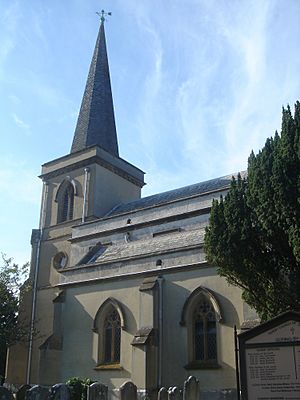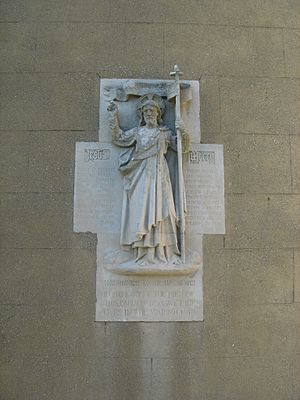St Mary's Church, Goring-by-Sea facts for kids
Quick facts for kids St Mary's Church |
|
|---|---|

The church from the southeast
|
|
| 50°48′47″N 0°25′29″W / 50.8130°N 0.4246°W | |
| Location | Sea Lane/Ilex Way, Goring-by-Sea, Worthing, West Sussex BN12 4UJ |
| Country | United Kingdom |
| Denomination | Church of England |
| Website | https://goringbyseaparish.org |
| History | |
| Status | Parish church |
| Dedication | Mary, mother of Jesus |
| Architecture | |
| Functional status | Active |
| Heritage designation | Grade II* |
| Designated | 21 May 1976 |
| Architect(s) | Decimus Burton |
| Style | Gothic Revival; original parts Transitional Norman |
| Administration | |
| Parish | Goring-by-Sea, St Mary |
| Deanery | Rural Deanery of Worthing |
| Archdeaconry | Chichester |
| Diocese | Chichester |
| Province | Canterbury |
St Mary's Church is an Anglican church located in Goring-by-Sea, part of Worthing in West Sussex, England. This old church was built in the late Norman period. It still has some parts from that time. However, a big update in 1837 by Decimus Burton gave it its current Gothic Revival look.
In 1954, a German artist named Hans Feibusch painted a special mural inside. This artwork is very impressive. It did cause some discussion when it was first shown. The church is considered very important for its history and design. It is protected as a Grade II* Listed building.
Contents
History of St Mary's Church
The area of Goring was first mentioned in the Domesday Book in 1086. This was a big survey of England ordered by William the Conqueror. Goring was different from other nearby places. It was part of a region called a "Rape" (an old county division) named after Arundel Castle.
Over time, Goring grew. People started building homes there in the 1800s. It became a main suburb of Worthing in 1929.
Building the First Church
There might have been a church in Goring during the Saxon times. However, we are not completely sure. A church dedicated to Mary was definitely built here in the late 1100s. It has been used for worship ever since.
The church stayed mostly the same until 1836. That's when a rich merchant named David Lyon bought land in Goring. He wanted to change the area. Lyon hired an architect, Decimus Burton, to redesign St Mary's Church.
The 1837 Redesign and a Famous Mural
Decimus Burton kept only a few original parts of the 12th-century church. These were the main arches inside the nave. Lyon paid for the entire rebuilding himself.
Later, a memorial for soldiers who died in World War I was added. It is a sculpture of Jesus on the outside south wall.
In 1954, a German artist named Hans Feibusch was asked to paint a mural. This painting was for the arch above the altar area. His artwork shows Christ in Majesty, which means Jesus as a powerful ruler. Many people think it's a great piece of art.
However, when the mural was first shown, some people in the church leadership were not happy. They thought the design was too bold and different. There was a court case about it within the church. The local Bishop, George Bell, helped solve the problem. The mural was finally shown in September 1954. This event was important for how art and the Church of England work together today.
Church Architecture and Design
Decimus Burton's design for St Mary's Church is in the Early English Gothic Revival style. It is quite simple. Some parts of the original 12th-century church still remain. These include parts of the nave (the main seating area) and some interior walls.
Key Features of the Building
The church has a tower at the west end. This tower has a tall spire on top and the main entrance door. Inside, there is a nave with a gallery at the back. A central arch leads to the chancel (the area around the altar). There is also a vestry (a room for the clergy) to the northeast. Another vestry was added in 1966. A separate church hall was built nearby in 1950.
The church is covered in smooth grey plaster. It has stone blocks and decorations. The roof is made of slate. Strong supports called Buttresses help hold up the chancel walls. The tower has three levels. The lower two levels are supported by corner buttresses. Above these is the belfry, where the bells are. It has tall, narrow windows. A decorative wall separates the belfry from the spire.
Inside the Church
Inside, the 12th-century arches in the nave have been changed a bit. The decorative tops of the pillars might be all Burton's work. The nave roof has a rib-vaulted design and is plastered. The chancel roof is similar. Both roofs have fancy decorations on their beams. The pulpit (where sermons are given) and pews (church benches) were added during a renovation in 1888.
The windows throughout the church are in the Decorated Gothic-style. They are tall and narrow, with two or three glass sections. The large window at the east end is an exception.
Monuments and Memorials
There are several old monuments inside the church. The oldest ones are two brass figures from around 1490. They show a husband and wife. A special painting called a funerary hatchment from 1860 remembers Sir George Richard Brooke-Pechell.
A stone bust from 1707 remembers Susan Cook. It is known for being very lifelike. There is also a white marble sculpture from 1841 by Francis Leggatt Chantrey. This one remembers Isabella Lyon, a relative of David Lyon.
The churchyard also has graves for soldiers from World War I. These are cared for by the Commonwealth War Graves Commission.
St Mary's Church Today
St Mary's Church was officially protected as a Grade II* Listed building on May 21, 1976. This means it is a very important historical and architectural site. In 2001, it was one of eight Grade II*-listed buildings in Worthing.
The church's parish covers a rectangular area in the southwest of Worthing. It stretches from the railway line in the north to the English Channel coast in the south.
St Laurence's Church
The parish also has a second church called St Laurence's Church. It was started in 1936 as a small chapel. It was built to serve the growing number of homes in the Sea Place area of Goring-by-Sea. A brick hall was used for worship until 1962. Another hall was added next to it, which was made bigger in 1969.
See also


